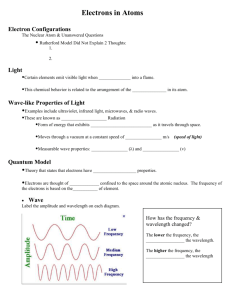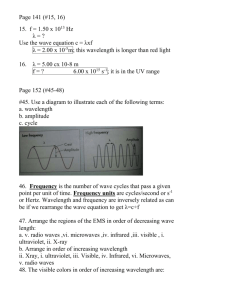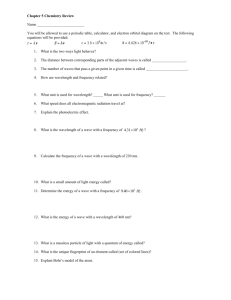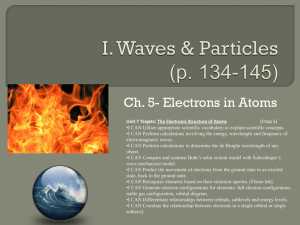Chemistry Quiz Ch. 5 Electron Configuration and Quantum Theory
advertisement
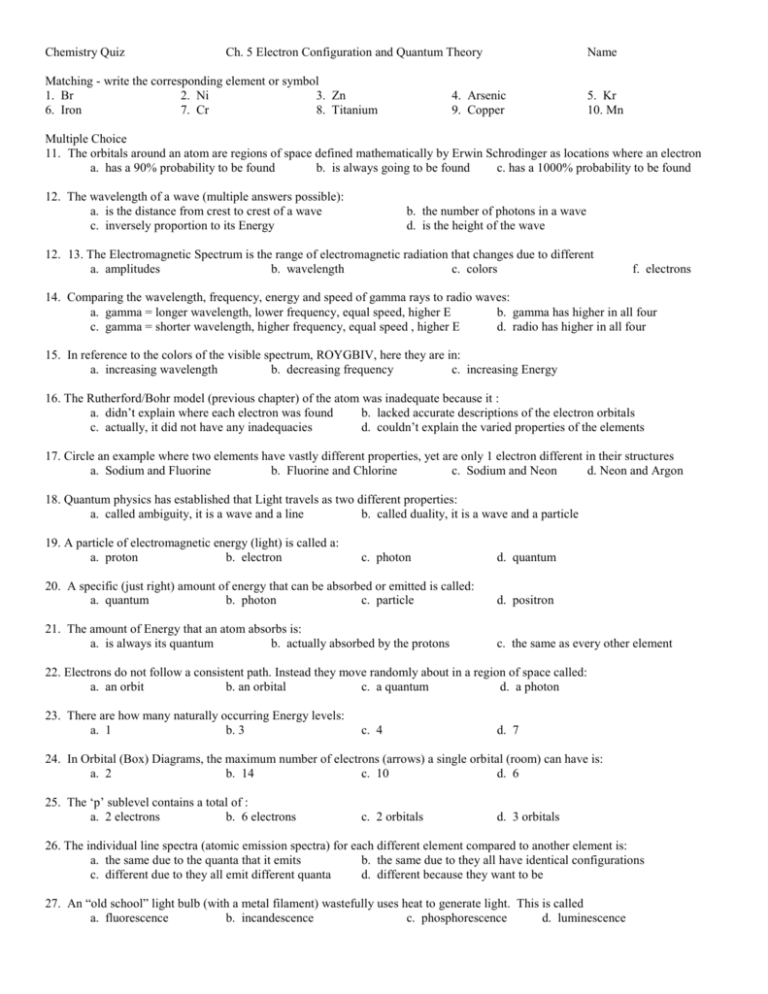
Chemistry Quiz Ch. 5 Electron Configuration and Quantum Theory Matching - write the corresponding element or symbol 1. Br 2. Ni 3. Zn 6. Iron 7. Cr 8. Titanium Name 4. Arsenic 9. Copper 5. Kr 10. Mn Multiple Choice 11. The orbitals around an atom are regions of space defined mathematically by Erwin Schrodinger as locations where an electron a. has a 90% probability to be found b. is always going to be found c. has a 1000% probability to be found 12. The wavelength of a wave (multiple answers possible): a. is the distance from crest to crest of a wave c. inversely proportion to its Energy b. the number of photons in a wave d. is the height of the wave 12. 13. The Electromagnetic Spectrum is the range of electromagnetic radiation that changes due to different a. amplitudes b. wavelength c. colors f. electrons 14. Comparing the wavelength, frequency, energy and speed of gamma rays to radio waves: a. gamma = longer wavelength, lower frequency, equal speed, higher E b. gamma has higher in all four c. gamma = shorter wavelength, higher frequency, equal speed , higher E d. radio has higher in all four 15. In reference to the colors of the visible spectrum, ROYGBIV, here they are in: a. increasing wavelength b. decreasing frequency c. increasing Energy 16. The Rutherford/Bohr model (previous chapter) of the atom was inadequate because it : a. didn’t explain where each electron was found b. lacked accurate descriptions of the electron orbitals c. actually, it did not have any inadequacies d. couldn’t explain the varied properties of the elements 17. Circle an example where two elements have vastly different properties, yet are only 1 electron different in their structures a. Sodium and Fluorine b. Fluorine and Chlorine c. Sodium and Neon d. Neon and Argon 18. Quantum physics has established that Light travels as two different properties: a. called ambiguity, it is a wave and a line b. called duality, it is a wave and a particle 19. A particle of electromagnetic energy (light) is called a: a. proton b. electron c. photon d. quantum 20. A specific (just right) amount of energy that can be absorbed or emitted is called: a. quantum b. photon c. particle d. positron 21. The amount of Energy that an atom absorbs is: a. is always its quantum b. actually absorbed by the protons c. the same as every other element 22. Electrons do not follow a consistent path. Instead they move randomly about in a region of space called: a. an orbit b. an orbital c. a quantum d. a photon 23. There are how many naturally occurring Energy levels: a. 1 b. 3 c. 4 d. 7 24. In Orbital (Box) Diagrams, the maximum number of electrons (arrows) a single orbital (room) can have is: a. 2 b. 14 c. 10 d. 6 25. The ‘p’ sublevel contains a total of : a. 2 electrons b. 6 electrons c. 2 orbitals d. 3 orbitals 26. The individual line spectra (atomic emission spectra) for each different element compared to another element is: a. the same due to the quanta that it emits b. the same due to they all have identical configurations c. different due to they all emit different quanta d. different because they want to be 27. An “old school” light bulb (with a metal filament) wastefully uses heat to generate light. This is called a. fluorescence b. incandescence c. phosphorescence d. luminescence 28. Below are samples of orbital diagrams that may or may not violate the 3 rules. State how it breaks a rule, or if it’s correct as it is. 29. Describe, in detail, what occurred for the chemicals in the flame test lab to emit visible light. (Quantum Physics) Give the electron configuration, noble gas shorthand, and orbital diagram for the following (3 things each): 30. Fluorine Config 31. Potassium Config Nobel Gas Nobel gas Diagram Diagram 32*. Cobalt Config 33**. Au Config 35. The wavelength is represented by which letter? a. A b. B c. C d. D e. E 36. The amplitude is represented by which letter? a. A b. B c. C d. D e. E 37. How many full waves are shown in the diagram? a. 1 b. 2 c. 3.5 d. 7 38. What is the unit for frequency? a. waves/ sec b. m/s Bonus: If a wave of electromagnetic light has a frequency of 1 x 1015 Hz and a speed of 3.0 x 108 m/s, what is its wavelength?




